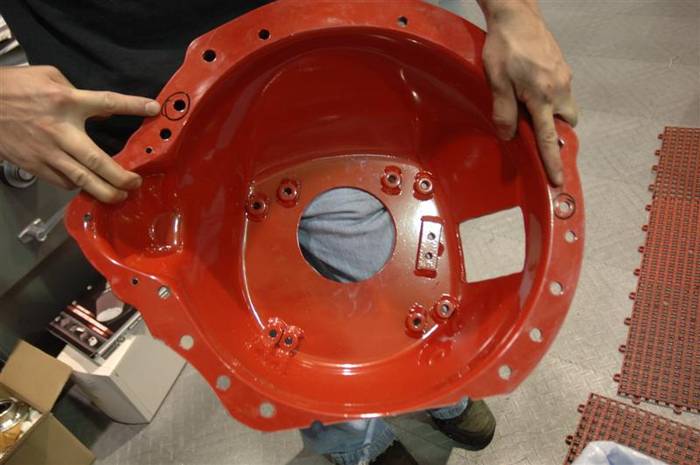Now, for the thing we always get a million questions on. Dialing in a bell housing. You may ask, "Why do I need to dial in my bell housing?" Good question. The bell housing is what holds the transmission on to the engine. The center of the transmission input shaft is supposed to be pointed directly at the center of the crankshaft. There is a pilot bearing/bushing in the end of the crankshaft. The bearing or bushing can be a true needle bearing, or it can be made out of bronze.
The snout on the input shaft of the transmission fits very snugly into the bearing/bushing. If they are not "perfectly" in line then the input shaft on the transmission will be cocked over and the bearing on the input shaft will start screaming it is UNHAPPY! Well, in a very short time, you will be unhappy too as you have to pull your interior, seats, tunnel, emergency brake cable, throw out bearing assembly, drive shaft, and drive shaft safety loop--for those of you who were smart and bought that option. (Nothing like a free wheeling drive shaft by the family jewels to give you an unexpected vasectomy if it unexpectedly comes loose or apart. But hey, look at the bright side--if it broke it'll probably be sharp, so it'll be quick--but probably not too painless...).

Anyway, it is about a 4 hour job to fix everything--(the tranny, that is, not the neutering). Signs of a bad alignment on the bell housing are: hard shifting, noisy front bearing, and if you are really unlucky, a complete failure of the bearing with lots of little metal parts scattered in your transmission.
So, to avoid purchasing stock in the antacid companies, please dial in your bell housing or have someone who is competent do it--I have seen several that are NOT competent. The current "record" is actually from a "professional" installer--0.139" out! That is more than 1/8 of an inch! The bearing didn't last 100 miles, but that was more than the warranty the installer gave and the customer was left out in the cold. The car ended up here where so many of them do that have had Backyard Bob working on them--right here back in our shop for a "tune up."
First thing to do is drill the dowel pin holes over sized in the bell housing--we drill them to 1/16 inch larger than the bushings we are going to weld in. Sandwich is kindly pointing to the 2 holes that need to be drilled out. They are circled with black magic marker.
